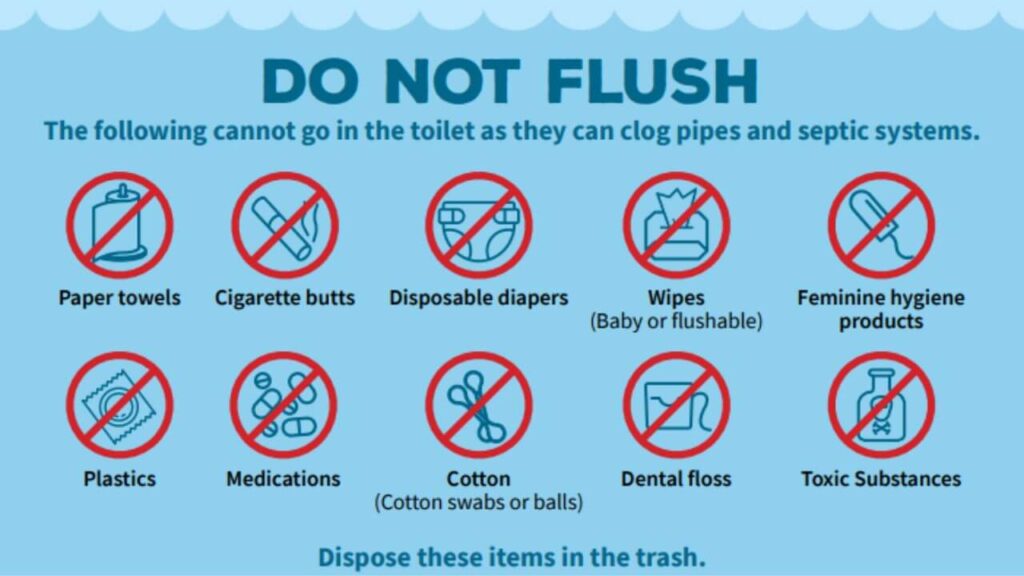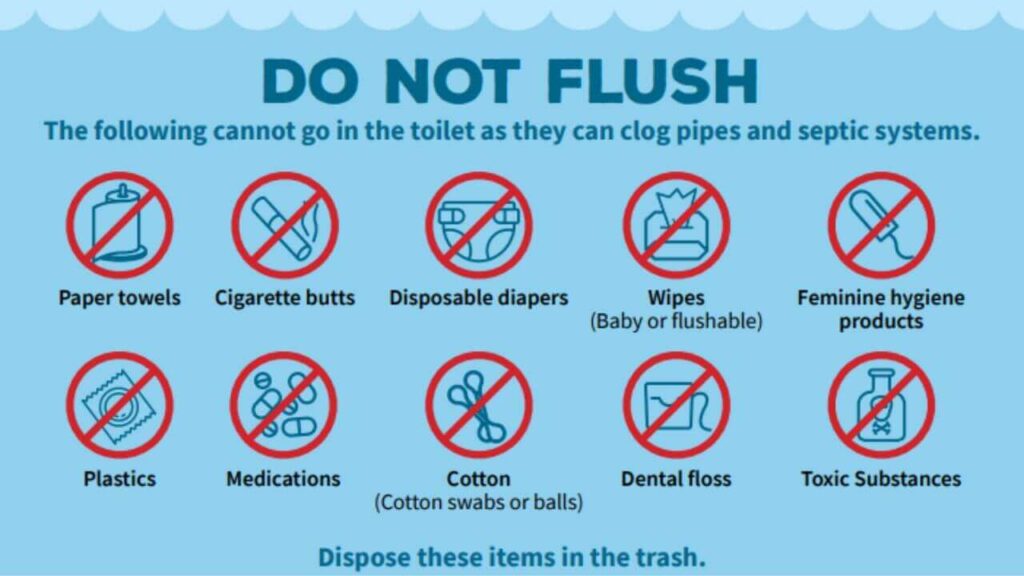Let me share my experience and list things you should never flush down the toilet. I learned the hard way after encountering plumbing issues.
Flushing inappropriate items can cause clogs, damage, and costly repairs. Items like wet wipes, feminine hygiene products, diapers, and paper towels can wreak havoc on your plumbing system.
Other culprits include dental floss, cotton balls, medications, and plastic materials.
Understanding the potential consequences and properly disposing of these items in the trash is essential to maintain a functioning and trouble-free toilet and plumbing system.
What Should I Not Flush Down The Toilet | List Of 20 Items

Here are 20 items that you should avoid flushing down the toilet, along with brief explanations as to why they can cause problems:
1. Wet Wipes
Wet wipes are not designed to break down easily in water like toilet paper.
When flushed, they can accumulate and clump together, causing blockages in both household pipes and sewage systems.
These clogs can lead to costly repairs and create environmental issues when sewage overflows occur.
2. Diapers
Diapers are made with super-absorbent materials that swell when they come into contact with water.
Flushing diapers can cause significant pipe blockages, leading to sewage backups and potential damage to plumbing systems.
Disposing diapers in the trash is the appropriate way to avoid these issues.
3. Feminine Hygiene Products
Tampons, pads, and liners are designed to be highly absorbent and do not dissolve quickly in water.
Flushing them down the toilet can cause pipe blockages and problems in the sewage system.
Proper disposal of the trash is essential to prevent these plumbing issues.
Related Post: What Happens If You Flush One Tampon Down The Toilet
4. Condoms
Condoms are made of latex or other non-biodegradable materials that do not break down in water.
Flushing condoms can lead to clogs in pipes and contribute to sewage system problems.
Properly disposing of condoms in the trash is crucial to prevent plumbing issues.
5. Dental Floss
Dental floss is a thin, strong string that does not easily break down in water.
When flushed, it can wrap around other debris, creating blockages in the plumbing system.
Disposing dental floss in the trash is the appropriate way to prevent clogs.
Related Post: Can You Flush Floss Down The Toilet
6. Cotton Balls and Swabs
Cotton balls and swabs can become entangled in pipes and plumbing fixtures, leading to blockages.
Their fibers do not break down quickly in water, making them unsuitable for flushing. These items should be thrown in the trash.
Related Post: Can You Flush Q Tips Down The Toilet
7. Medications
Flushing medications down the toilet can contaminate water sources and harm aquatic life.
Wastewater treatment facilities cannot effectively remove all pharmaceutical compounds, leading to potential environmental damage.
Unused or expired medications should be taken to designated drop-off points for proper disposal.
Related Post: Why Can’t You Flush Toilet After Drug Test
8. Hair
Hair can accumulate in pipes over time, especially in households with people with long hair or pets.
This accumulation can lead to clogs and drainage issues in the plumbing system.
Properly disposing of hair in the trash prevents these problems.
Related Posts:
Can You Flush Hair Down The Toilet
9. Paper Towels
Unlike toilet paper, paper towels do not disintegrate quickly in water.
Flushing paper towels can cause blockages in pipes and create plumbing issues. They should be thrown in the trash instead.
Related Posts:
How To Unclog A Toilet With Paper Towels In It
Will Paper Towel Dissolve In Clogged Toilet
10. Cigarette Butts
Cigarette butts are made of non-biodegradable materials and contain harmful chemicals from tobacco.
Flushing them can release these chemicals into water sources and harm the environment. Properly disposing of cigarette butts in the trash is essential.
Related Post:Can You Flush Tobacco Down Toilet
11. Grease or Cooking Oil
Grease and cooking oil solidify when cool, leading to pipe clogs and sewage system blockages.
It is important to avoid pouring grease or oil down the toilet or sink and instead dispose of it in a sealed container in the trash.
Related Post: Can You Flush Oil Down The Toilet
12. Cat Litter
Cat litter can clump and expand when wet, causing blockages and potential damage to plumbing systems.
Flushing cat litter can also introduce harmful pathogens into the sewage system. It should be disposed of in the trash.
13. Bandages or Adhesive Strips
These items do not break down in water and can cause blockages in pipes. Properly disposing of bandages and adhesive strips in the trash is essential to prevent plumbing issues.
Also Post: Can I Use Toilet Paper As Gauze | Let’s Find Out
14. Plastic Items
Plastic bags, wrappers, and other materials can clog pipes and harm the environment. Flushing plastic items is inappropriate and should always be disposed of in the trash.
Related Post: What Happens If You Flush Plastic Down The Toilet
15. Disposable Diapers
Similar to diapers mentioned earlier, disposable diapers absorb moisture and expand, causing plumbing issues and damage when flushed. Proper disposal of the trash is essential to avoid these problems.
16. Hair Dyes or Coloring Agents
Chemicals from hair dyes and coloring agents can contaminate water sources and harm the environment.
Flushing these chemicals is unsafe; they should be disposed of properly following the manufacturer’s instructions.
17. Nail Clippings
Nail clippings do not break down in water and can contribute to pipe blockages. They should be disposed of in the trash to prevent plumbing issues.
18. Pet Waste
Pet waste can contain harmful bacteria and pathogens, making it unsuitable for flushing. Flushing pet waste can also contaminate water sources.
Properly disposing of pet waste in the trash or using designated pet waste disposal systems is important.
19. Paint or Paint Thinners
Paint and paint thinners contain toxic chemicals that can contaminate water sources. Flushing them down the toilet is hazardous to the environment.
These materials should be disposed of through proper hazardous waste collection facilities.
20. Expired or Unused Medications
As mentioned earlier, flushing medications can lead to water pollution and harm aquatic life.
Exposing expired or unused medications through designated collection points helps protect the environment.
Remember, toilets are designed to handle human waste and toilet paper.
Flushing anything else can lead to plumbing problems, environmental damage, and increased water treatment costs.
Proper disposal in the appropriate waste bins or recycling facilities is essential for maintaining a functioning plumbing system and protecting the environment.
What Can Damage A Toilet?
I know many people have no idea what things can damage their toilet. If you are one of them, let me guide you related this information to your toilet’s long life.
Several things can potentially damage a toilet. Here are some common factors:
1. Flushing Inappropriate Items
Flushing items other than human waste and toilet paper, such as wet wipes, diapers, feminine hygiene products, or paper towels, can lead to clogs and damage to the plumbing system.
2. Excessive Force
Slamming the toilet seat or lid can crack the porcelain or damage the hinges, leading to instability or breakage.
3. Using Abrasive Cleaners
Harsh chemicals or abrasive cleaning tools can scratch or erode the porcelain, damaging the toilet’s surface over time.
4. Hard Water Deposits
Mineral deposits from hard water can build up inside the toilet bowl and affect the flushing mechanism, leading to reduced efficiency or clogs.
5. Improper Installation
Incorrect toilet installation, such as using incorrect seals or improper connection to the plumbing system, can cause leaks, instability, or damage.
6. Impact or Physical Damage
Accidental impacts or dropping heavy objects on the toilet can cause cracks, fractures, or breakages in the porcelain or tank.
7. Corrosion or Rust
If the toilet’s metal parts, such as bolts or fittings, are exposed to moisture or chemicals for extended periods, they can corrode or rust, compromising their structural integrity.
To maintain a toilet’s functionality and longevity, it is important to follow proper usage guidelines, avoid flushing inappropriate items, use gentle cleaning agents, and promptly address any repairs or maintenance needs.
Also Read:
What Can Be Flushed Down The Toilet
Can You Flush Beard Hair Down The Toilet
Can I Flush Bugs Down The Toilet
Which Things Are Ok To Flush Down The Toilet?
The only things generally considered okay to flush down the toilet are human waste and toilet paper specifically designed to be flushable.
Human waste, including urine and feces, can be flushed without causing harm to the plumbing system when combined with adequate water flow.
Toilet paper designed to break down quickly in water is also suitable for flushing. Look for toilet paper labeled as “septic-safe” or “flushable” to ensure it is designed to dissolve easily.
It’s important to note that even with these items, it’s best to flush them in moderation to avoid overloading the plumbing system and potential clogs.
It’s always a good practice to follow local guidelines and regulations related to waste disposal to ensure the proper functioning of plumbing systems and environmental protection.
Also Read:
12 Toilet Flushing Issues And How To Fix Them
What’s The Biggest Thing You Can Flush Down A Toilet?
What Is The Proper Way To Flush A Toilet?

Many people would be wondering about the proper way to flush a toilet. Right? Well, To properly flush a toilet, follow these steps:
Step 1: Press The Flush Lever Or Button
Depending on the toilet design, locate the flush lever on the toilet tank or the flush button on top of the tank or the wall.
Step 2: Hold The Lever/Button Down
Press the lever/button and hold it until the toilet bowl empties completely. This ensures that the waste is effectively flushed away.
Step 3: Release The Lever/Button
Once the water in the toilet bowl has completely emptied, release the flush lever or button. This allows the tank to refill with fresh water.
Step 4: Wait For The Tank To Refill
The toilet tank will automatically start refilling with water. Wait until the tank is fully refilled and you no longer hear the sound of running water.
Step 5: Check For The Proper Water Level
Ensure that the water level in the toilet bowl has returned to its normal level. It should be sufficient height to cover the bottom of the bowl.
Step 6: Repeat If Necessary
If additional flushing is needed, repeat the process as necessary.
Remember, it’s important only to flush appropriate items like human waste and toilet paper specifically designed to be flushable.
Avoid flushing other materials that can cause clogs or damage the plumbing system.
Also Read:
How to Flush a Toilet for Dummies
How To Flush Toilet Without Running Water?
How To Flush Poop That Is Too Big To Flush
Bottom Line
In conclusion, it is crucial to avoid flushing anything other than human waste and toilet paper designed to be flushable.
Items such as wet wipes, diapers, feminine hygiene products, and other non-flushable materials can cause clogs, damage plumbing systems, and harm the environment. Proper waste disposal is essential.
